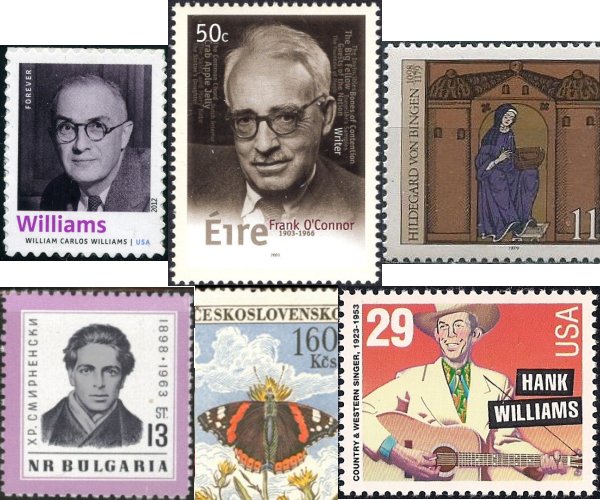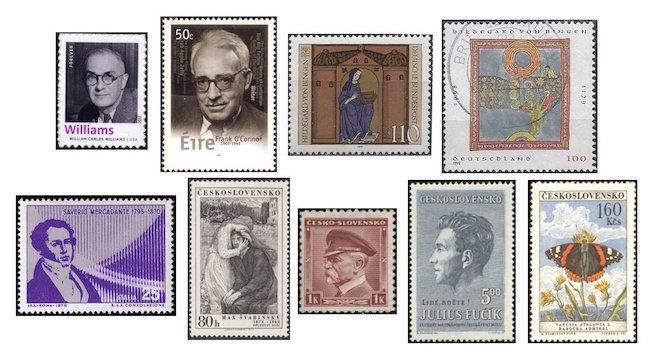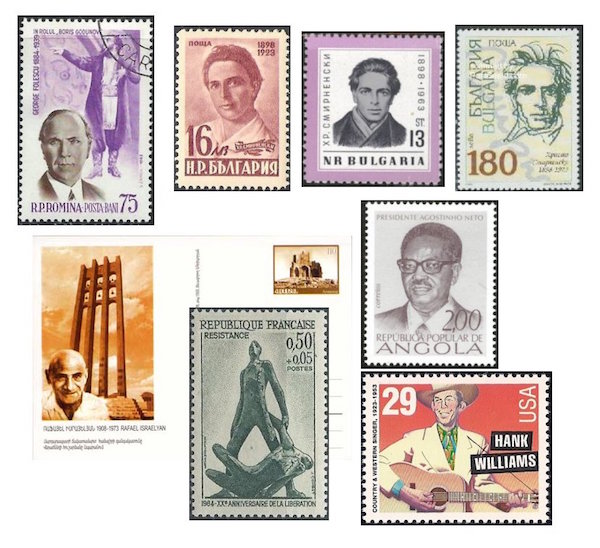The Arts on Stamps of the World — September 17
An Arts Fuse regular feature: the arts on stamps of the world.

By Doug Briscoe
Two top-ranked writers of the 20th century, William Carlos Williams and Frank O’Connor, are among today’s birthday offerings on Arts on Stamps of the World. Another Williams of a very different category altogether, Hank Williams, is also in the lineup, and we note the 818th anniversary of the death of Hildegard of Bingen.
William Carlos Williams (September 17, 1883 – March 4, 1963) was one of ten 20th-century American poets selected for a 2012 issue from the USPS. (Four of the others have birthdays next month!) Williams’ ethnicity was an interesting “melting pot” mixture: his father, born in Puerto Rico, was English, and his mother was French Basque and Dutch Jewish. Williams was born in New Jersey. Between the ages of 14 and 16 he was schooled in Switzerland. He studied medicine and was a practicing physician (pediatrics and general medicine) all his professional life. His first book of poetry appeared in 1909, when he was 25. His important volume, Spring and All, had the misfortune to come out in the same year as The Waste Land. Williams was something of a mentor to Allen Ginsberg.
Irish writer Frank O’Connor (born Michael Francis O’Donovan; 17 September 1903 – 10 March 1966) served with the IRA after World War I and was imprisoned in 1922-23. He taught the Irish language and worked as a librarian. In 1935 he joined the board of directors of W. B. Yeats’ Abbey Theatre in Dublin and became its director two years later. O’Connor was primarily a writer of short stories, but also produced novels, plays, criticism, travel, and two memoirs, An Only Child and the posthumously published My Father’s Son.
September 17 is also the day (in 1179) on which the abbess, writer, mystic, and composer
Hildegard of Bingen died. She was born in or around the year 1098. She entered a Benedictine monastery in childhood and subsequently established her own monastery in 1150 and another in 1165. An extraordinary polymath, she wrote on theology, natural science, botany, medicine, etc. Her 400 extant letters, some to emperors and popes, constitute the largest surviving correspondence from her time. Besides all this, she composed at least seventy pieces of music, including most notably the Ordo Virtutum, regarded as perhaps the earliest Medieval morality play. Her music has received many recordings within the last few decades. She experienced visions from the age of five and was beatified, but not officially canonized until just four years ago (800 years after her death), when she was recognized as a Doctor of the Church by Pope Benedict XVI. Today is her feast day.
Italian composer Saverio Mercadante was baptized September 17, 1795. His reputation lies mainly in the operatic field, but he also wrote many works in other genres, including a symphony based on themes from Rossini’s Stabat Mater (among his sixty or so other symphonies), twenty concertos, seventeen quartets, much sacred music, etc. His life was a mixture of good and bad fortune. Born illegitimate, he grew up in poverty, but by means of a forged birth certificate he was able to enter the Conservatorio di San Sebastiano in Naples; he lost the sight of one eye in 1838 and went completely blind after a stroke in 1862. On the other hand his musical career was one of considerable success and financial reward. He died on December 17, 1870.

Czech artist Max Švabinský (17 September 1873 – 10 February 1962) is held to be one of the founders of Czech modernism despite the traditional aspect of much of his work. After concentrating on painting in his younger days, Švabinský became interested in exploring etching and Mezzotint. It is one of the early paintings, The Confluence of Souls (Splynutí duší, 1896-97) that is shown in monochrome on the stamp. He worked as a professor at the Prague Academy from 1910, and in the years to come designed banknotes and a large number of postage stamps, including these three of Jan Masaryk (1935), journalist and Nazi victim Julius Fučík (1951) and the Red Admiral butterfly (1961) from a set of nine butterfly stamps. Another example of Švabinský’s work can be seen in the stained glass windows he designed for St. Vitus Cathedral in Prague.
September 17 is also the birthday of Romanian bass George Folescu, born Gheorghe Folea in 1884. He studied at the Bucharest Conservatory under Demeter Popovici, whose stamp we saw on July 23. In 1911 Folescu made his debut in Brasov (Kronstadt) as Alfio in Cavalleria Rusticana. Three years later he joined the Bucharest National Opera and in time came to be regarded as one of the most significant Romanian singers of his day, taking on many of the signature bass roles: Boris Godunov, Don Giovanni, Mefistofele, Ramphis, Scarpia, and Osmin among them. He also sang in oratorio and in concert, as well as interpreting folk song and teaching at the Bucharest Conservatory. He took his own life in 1939.
One measure of the significance of an individual, I suppose, is the frequency with which that individual appears on the stamps of his or her nation. In spite of the brevity of his life, Bulgarian poet and prose writer Hristo Smirnenski (September 17, 1898 – June 18, 1923) has at least three, from 1948, 1963, and 1998 (the centennial). Born Hristo Izmirliev, the teen saw his hometown of Kukush burned by Greek soldiers during the Second Balkan War, with the result that he and his family became refugees, fleeing to Sofia. He was still only seventeen when he began writing for a satirical newspaper. He began using the pseudonym Smirnenski in 1917 (this was but one of dozens of pen names he used in his prolific writings), and his first poems appeared in print in April of the following year. He witnessed more violence when the government suppressed the Soldiers’ Revolt, which solidified his socialist leanings. He joined the Communist Party in 1921. A second volume of poetry from early 1922 confirmed his popularity. His work is marked by humor and humanism, hope and optimism, but his health was ruined by tuberculosis, and he died the next year at the age of 25.

The important Armenian architect Rafael Israelyan (September 17, 1908 – September 8, 1973), born in Tbilisi, created many distinctive monuments in his country and three Armenian churches beyond its borders, two in Italy and Uruguay and, most notably, St. Vartan Cathedral in New York. The 1998 postal card shows the artist with two of his most striking designs, both of them memorials to battles that took place in 1918. Behind his image is the Sardarapat Memorial, and in the upper right corner is the Monument to the Battle of Bash-Aparan (built to Israelyan’s design in 1979). A second view from another angle can be seen here.
Another artist who created memorials for his countrymen was Toulouse-born sculptor Gaston Watkin (17 September 1916 – 2 May 2011). One of his most celebrated works is the Monument to the Students of the Resistance (1954, unveiled 1956) in the Luxembourg Gardens in Paris. This object was used as the illustration for a 1964 stamp remembering the 20th anniversary of the Resistance. Watkin also made a number of religious pieces, including the Immaculate Conception (the “Black Virgin”) created for the church of Notre-Dame de Royan in 1958, and many of his other works grace college campuses across France.
Agostinho Neto (17 September 1922 – 10 September 1979) was not only the first President of independent Angola (from 1975 to 1979), he is also regarded as that country’s finest poet. Both of his parents were teachers, and Neto studied medicine in Portugal (Angola having been a Portuguese colony until 1975). He became very active politically and suffered arrest by Portuguese authorities on four occasions by 1960, the last time for his association with the Communist-inclined Popular Movement for the Liberation of Angola, of which he was president. Thirty protesters were killed and two hundred wounded when they marched for his release. He escaped from captivity some time later but was unable to achieve substantive gains until Angola achieved independence. His poetry was written mostly in Portugal between the end of World War II and his 1960 arrest. Three volumes were published. His birthday is a national holiday in Angola.
Hank Williams (September 17, 1923 – January 1, 1953) was born Hiram Williams in Alabama and got his musical start in radio in 1937, aged 15. He suffered from spina bifida, which, although it did not seem to affect his posture significantly, led him to the abuse of alcohol and drugs that contributed to his premature demise at age 29. One of his idols had been Roy Acuff, whose stamp we saw here just two days ago. Both men have been styled “The King Of Country Music”.
It was on this date in 1630 that the city of Boston, Massachusetts was founded.
A graduate of the University of Massachusetts with a B.A. in English, Doug Briscoe worked in Boston classical music radio, at WCRB, WGBH, and WBUR, for about 25 years, beginning in 1977. He has the curious distinction of having succeeded Robert J. Lurtsema twice, first as host of WGBH’s weekday morning classical music program in 1993, then as host of the weekend program when Robert J.’s health failed in 2000. Doug also wrote liner notes for several of the late Gunther Schuller’s GM Recordings releases as well as program notes for the Boston Classical Orchestra. For the past few years he’s been posting a Facebook “blog” of classical music on stamps of the world, which has now been expanded to encompass all the arts for The Arts Fuse.
